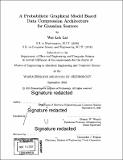A probabilistic graphical model based data compression architecture for Gaussian sources
Author(s)
Lai, Wai Lok, M. Eng. Massachusetts Institute of Technology
DownloadFull printable version (14.08Mb)
Other Contributors
Massachusetts Institute of Technology. Department of Electrical Engineering and Computer Science.
Advisor
Gregory W. Wornell.
Terms of use
Metadata
Show full item recordAbstract
Data is compressible because of inherent redundancies in the data, mathematically expressed as correlation structures. A data compression algorithm uses the knowledge of these structures to map the original data to a different encoding. The two aspects of data compression, source modeling, ie. using knowledge about the source, and coding, ie. assigning an output sequence of symbols to each output, are not inherently related, but most existing algorithms mix the two and treat the two as one. This work builds on recent research on model-code separation compression architectures to extend this concept into the domain of lossy compression of continuous sources, in particular, Gaussian sources. To our knowledge, this is the first attempt with using with sparse linear coding and discrete-continuous hybrid graphical model decoding for compressing continuous sources. With the flexibility afforded by the modularity of the architecture, we show that the proposed system is free from many inadequacies of existing algorithms, at the same time achieving competitive compression rates. Moreover, the modularity allows for many architectural extensions, with capabilities unimaginable for existing algorithms, including refining of source model after compression, robustness to data corruption, seamless interface with source model parameter learning, and joint homomorphic encryption-compression. This work, meant to be an exploration in a new direction in data compression, is at the intersection of Electrical Engineering and Computer Science, tying together the disciplines of information theory, digital communication, data compression, machine learning, and cryptography.
Description
Thesis: M. Eng., Massachusetts Institute of Technology, Department of Electrical Engineering and Computer Science, 2016. Cataloged from PDF version of thesis. Includes bibliographical references (pages 107-108).
Date issued
2016Department
Massachusetts Institute of Technology. Department of Electrical Engineering and Computer SciencePublisher
Massachusetts Institute of Technology
Keywords
Electrical Engineering and Computer Science.